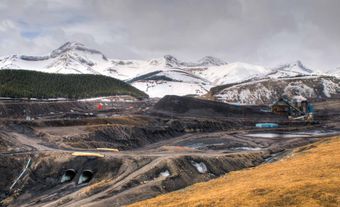Coal Liquefaction
Coal liquefaction is a process that converts coal from a solid state into liquid fuels, usually to provide substitutes for petroleum products. Coal liquefaction processes were first developed in the early part of the 20th century but later application was hindered by the relatively low price and wide availability of crude oil and natural gas. Large scale applications have existed in only a few countries, eg, Germany during WWII and South Africa since the 1960s. The oil crises of the 1970s and the threat of depletion of conventional oil supplies sparked a renewed interest in the production of oil substitutes from coal during the 1980s. However, as was the case for coal gasification, the wide availability of inexpensive oil and natural gas supplies in the 1990s has effectively killed the near-term commercial prospects of these technologies.
Direct Coal Liquefaction
Coal can be liquefied by direct and indirect process routes. Direct coal liquefaction was developed as a commercial process in Germany based on research pioneered by Friedrich Bergius. Seven direct liquefaction plants were in operation in Germany just before WWII. Five additional plants were constructed during the war and produced more than 3 million t of oil per annum. These plants produced about 90% of the available aviation fuel for the German war effort.
Most of the direct processes developed in the 1980s were modifications or extensions of Bergius's original concept. The coal is ground so that it can be mixed into a coal derived recycle solvent to form a coal-oil slurry feed. The slurry containing 30-50% coal is then heated to about 450°C in a hydrogen atmosphere between 13 900-20 900 kPa pressure for about one hour.
A variety of catalysts are used to improve the rates of conversion to liquid products. One tonne of coal yields about one-half tonne of liquids. Processes have been developed to use coals from low rank lignites to high volatile bituminous coals. Higher-rank coals are less reactive and anthracites are essentially non-reactive.
The liquids produced have molecular structures similar to those found in aromatic compounds and need further upgrading to produce specification fuels such as gasoline and fuel oil.
Indirect Coal Liquefaction
Indirect liquefaction processes were developed in Germany at the same time as direct processes. In the early 1920s, Franz Fischer and Hans Tropsch patented a process to produce a mixture of alcohols, aldehydes, fatty acids and hydrocarbons known as synthol, from a synthesis gas of hydrogen and carbon monoxide.
The Fischer-Tropsch (F-T) process forms the basis for indirect liquefaction of coal. The process is indirect since the coal structure is completely broken down into synthesis gas by gasification with steam and oxygen. Then the synthesis gas is reacted over an appropriate F-T catalyst to form predominantly paraffinic liquid hydrocarbons having wide molecular weight.
This method was used to produce motor fuel during WWII and South Africa has used it to produce motor fuels and petrochemical feedstocks since the 1960s. The indirect route yields a large number of byproducts and overall has a lower thermal efficiency.
Research
In Canada, coal liquefaction research was conducted during the 1980s and early 1990s by the Alberta Research Council in Devon, Alberta, and the CANMET Energy Technology Centre (CETC) in Ottawa, the energy science and technology arm of Natural Resources Canada. Both facilities have shown that the simultaneous processing or co-processing of coal and oil sand bitumen - a combination of direct coal liquefaction and heavy oil upgrading - could be a viable and unique alternative for Alberta, where large reserves of these resources are found in close proximity. The research has also shown that co-processing is cheaper than direct coal liquefaction and, at high enough oil prices, more cost-effective than heavy oil upgrading. All coal liquefaction research was terminated in the mid-1990s.

 Share on Facebook
Share on Facebook Share on X
Share on X Share by Email
Share by Email Share on Google Classroom
Share on Google Classroom

